Vedic Musical Cosmology
By Richard Merrick
Thought by some to be the oldest religion on Earth, the Hindu religion was born in the Indus valley south of the Tibetan mountains. Its precepts, as set forth in the written Vedic hymns and appendices known as the Upanishads, are based on the divine origin of ‘what is heard’ called sruiti.
Everything in the Vedic tradition originates in harmonic principles starting with the first sound ‘OM’ or ‘Aum.’ As this concept was adopted into virtually every religion on Earth, music became the foundation of human spirituality and provided the model of coherence necessary for social organization and government. But at the center of all this was a cosmology of birth and rebirth based on the harmony readily apparent to ancient astronomers in the planetary cycles.
It starts with the concept of the World Egg, also called the Cosmic Egg. This is the idea that the Earth is inside a giant egg. Early philosophers may have deduced this from the relative sizes of the Earth and Moon, which can fit together fit inside the geometrical proportions of a common hen’s egg.
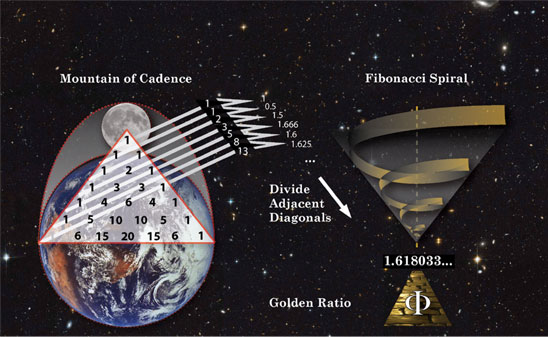
To early Vedic scholars, the egg was held together by a great world mountain, or ‘mountain of cadence,’ named Meru. Believed to be the vertical axis of the universe, Mount Meru (or Sumeru) was thought to rise into the clouds like a gigantic Babylonian ziggurat, providing natural terraces for the gods to live and dance. Around its majestic form revolved the Sun, Moon and stars.
According to Pingala in The Art of Prosody (450-200 BC), Meru was the symbol for a pyramid of numbers arranged such that their diagonals would generate the Fibonacci series {1, 1, 2, 3, 5, 8, 13, 21, 34, 55, 89, 144, …}.
The important thing to realize about the Fibonacci series is it converges to the golden ratio constant (‘divine proportion’) of about 1.618033 by dividing the sum of each adjacent diagonal in Mount Meru. Indeed, this process forms a spiral that twirls into the center of the pyramid like a vortex even as the pyramid grows larger. This concept was explained in the Vedas as the gold of Kubera.
While Indra (the sun) is the king of the gods in this supernal realm, the lord of Mount Meru is Kubera who rules a great city of gold at the summit. His regular attendants are the Nagas or cobra-serpents who help him hide his gold deep inside their serpent holes. His gold is then protected by Shukra, the sky god of Venus who hovers above.
In this most ancient legend we find the prototype for the Biblical afterlife, a mountaintop where the heavenly host sings eternal. This is where the streets are paved in gold. This is the place where Indra, Zeus and Yahwah live. This is the Abrahamic vision of heaven – a vision now disconnected with the natural world.
So we find the gold in Meru is not a material gold at all but instead the golden mean constant of nature. This Venus protects with her pentagonal orbit around the Sun.
The planet Venus has been the prime feminine archetype for God and fertility across many cultures and religions. She was personified as Shukra in the Indian Vedas, Inana in ancient Sumer, Ishtar in Assyria and Babylonia, Isis in Egypt, Lilith in ancient Israel, Astarte or Aphrodite to the Greeks, Freyja to to Nordics, Quetzalcoatal to the Maya and Venus to the Romans.
In every case, Venus was considered the goddess of love, beauty and music and was often associated with a 5-pointed star or pentagram. The reason for this association is found in the astronomical fact that Venus traces out a pentagonal rose pattern in the sky as seen from Earth over an 8-year period. In fact, the orbital proportion of Venus to Earth is 13:8, a Fibonacci proportion of 1.625 very near the golden ratio. In fact, the golden mean itself can be found inside the retrograde loop of Venus, marking the presence of a stabilizing golden section in the Sun’s heliospheric plasma current sheet.
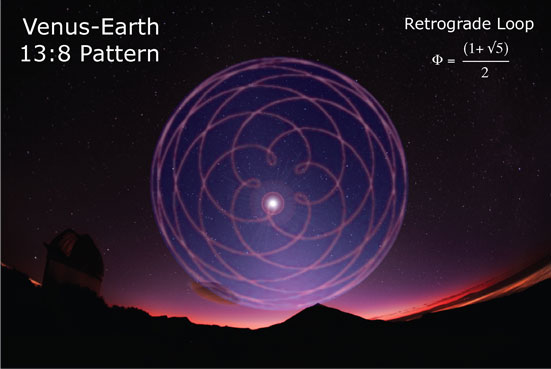
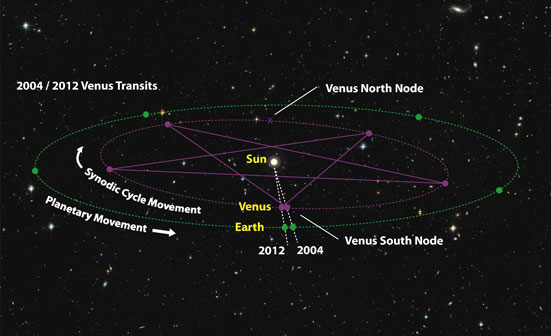
In ancient times, this orbital pentagram of Venus was very well known and deeply revered. It was called the Morning Star, the Evening Star, the Babylonian Ishtar, the Star of Bethlehem and the Light Bringer (Lucifer in Latin). Gnostic followers of this star believed it brought enlightenment and wisdom to all those who studied it.
It was this pentagonal star that was the most likely source for Venus’ attributes of love, beauty and music. It offered hope and an undisputable proof of order and divine intelligence in the cosmos. After all, how could anyone think life is random and meaningless when the same star is found in the seed pattern of an apple, the five petals of a rose and even their own anatomy?
Long before the Greeks, Indian shaman described the star in theological terms as the Sun inseminating the orbital pattern of Venus, giving birth to the World Egg.
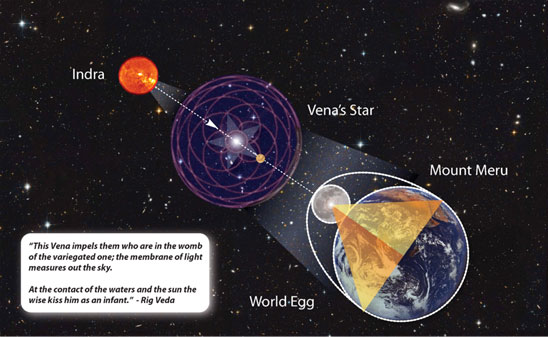
In Indian literature, Venus has many attested names including Bhrgu, Kavya, Kavi Usanas, and Shukra. An early 20th century Indian researcher named B.G. Tilak proposed that an early Vedic name for Venus was Vena. For example, Vena is mentioned in the Rigveda 10.123 in a hymn dedicated to Shukra, describing her as compelling Shukra to be born from the sun.
‘This Vena impels them who are in the womb of the variegated one; the membrane of light measures out the sky.
At the contact of the waters and the sun the wise kiss him as an infant.’
This hymn later explicitly calls Vena the ‘son of the sun.’
We can understand this as a theological interpretation of a rare cosmological occurrence known as the Venus Transit. It was well known in ancient times that Venus transits between the Earth and Sun in long cycles of either 105.5 or 121.5 years within a double pattern repeating every 243 years. Historian Subhash Kak explains the Venus Transit in Hindu cosmological terms:
‘In India, the dichotomy is more symmetric: Budha (Mercury) is Vishnu, the younger brother of Indra, the great god, the sun who is also later represented by S_hiva; whereas Shukra (Venus) is the teacher of the asuras (demons).
Shukra knows the secret of immortality; this presumably has reference to the fact that Venus emerges again after being swallowed by the sun [during the Venus Transit]. In the Shaivite glosses of this story Shukra is swallowed up by Shiva and later on expelled as semen; this is a play on the etymology of Shukra as bright.’
Thus, we find that the Sun god Indra impregnates the Venus god (Shukra) under the guidance of the feminine aspect of God named Vena (the Venus Star) as a ‘membrane of light.’ The etymology of the word ‘shukra’ is actually ‘bright, clear, semen’ while the ‘womb of the variegated one’ is a reference to Vena’s Star. Thus, the Sun’s shukra passes through Vena’s star to be born as ‘an infant’ on Earth as the two are rise together above the horizon of the ocean.
In the Venus Transit, we find perhaps the earliest concept of virgin birth as the Sun’s ‘membrane of light’ shining through Venus, giving birth to life on Earth. This light is the feminine Shekinah resonance – the cloud, halo or glory described in the Hebrew Bible – passing through the pentagonal ‘birth canal’ of Venus from Indra. In this most ancient interpretation, the sacred feminine is revealed not only as a Jewish-Christian and Hebrew tradition, but a celebration of celestial fertility and rebirth rooted in Vedic cosmology far predating Abraham.
We also find it as a key element in an ancient musical theory of everything or musica universalis. As the early plasma disc resonated in circular waves in and out from the Sun, calm damping rings formed at right angles on a giant golden spiral where material collected. As the plasma cooled, the planets formed at calm, harmonically damped locations. Becoming warped by the shrinkage of the cooling solar disc as it began to spiral through the curved and polarized galactic disc, the planets settled into elliptical orbits just outside of the Sun’s equatorial plane. Thus began the music of the spheres – a music made of pure light and atomic resonance at an epic scale.
As it happens, Shukra (Venus) is celebrated on a specific month in the Hindu calendar called JyeshTha, corresponding to May-June. Earth is currently in a period when the Venus Transit occurs in June, last time on June 8, 2004 and next on June 5-6, 2012. According to the Mayan Tzolken calendar, the transit in 2012 represents the end of a very long Venus cycle and is the birth of a new Venus. As this precedes the end of the Fifth Mayan Sun, occurring just six months later on December 21st, the two celestial events together mark the end of an astronomical epoch of 25,625 years. As the Chinese might say, this year of 2012 is most auspicious indeed!
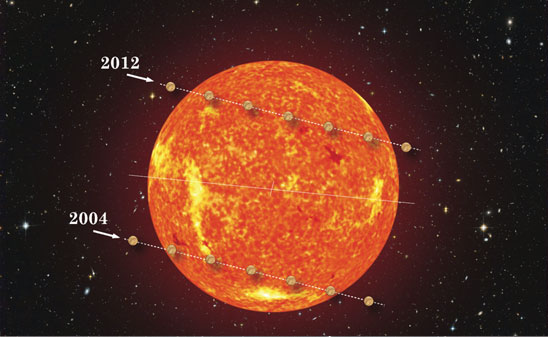
Content courtesy of Richard Merrick
Copyright (c) 2011. All Rights Reserved.









